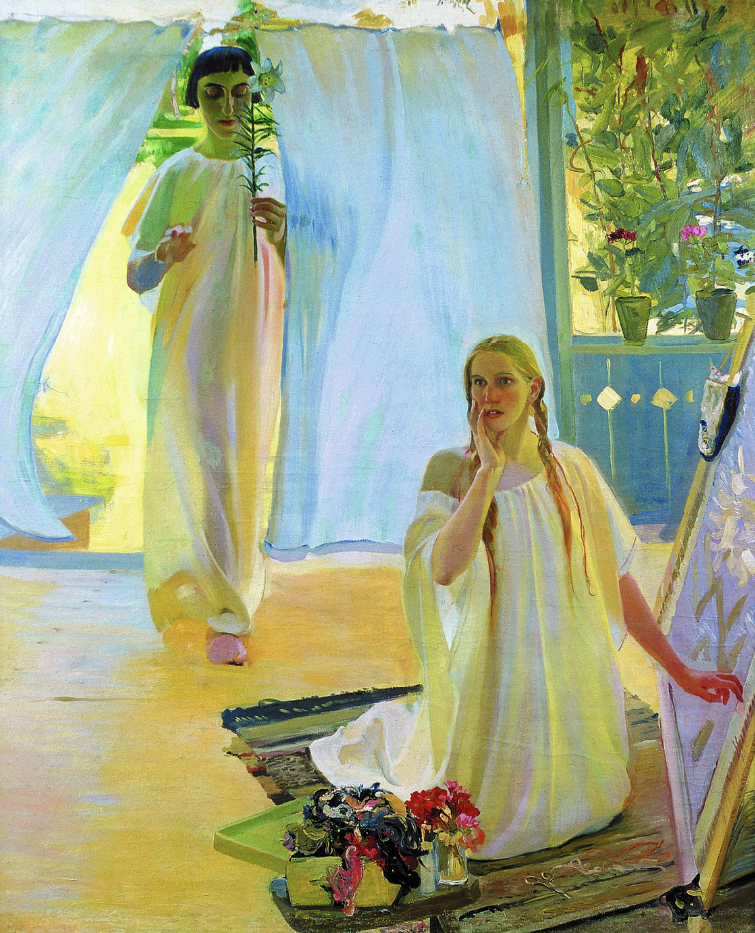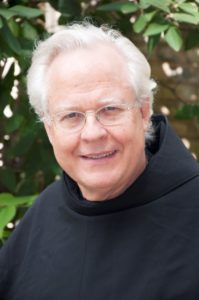
The Annunciation, 1907-1908 (Oleksandr Murashko – Ukrainian, 1875–1919) is part of the Permanent Collection of the National Art Museum of Ukraine, in Kyiv. https://www.artsy.net/artwork/oleksandr-murashko-the-annunciation
Newman as a Volcanic Eruption
Hail, full of grace! The Lord is with you.
The Archangel invited Mary to conceive the Son of God[1] by the power of the Holy Spirit. Her reply motivates us: “Behold, I am the handmaid of the Lord. May it be done to me according to your word.” Love for Mary at home and in Catholic grade school prompted me to ask; why did it take so long, until 431 at the Council at Ephesus to declare that the Blessed Virgin Mary is the Mother of God? Little did I know that I was raising the question of development of doctrine, a question which, a decade later, would be at the heart of the Second Vatican Council. Development of the reform within the Church came when I assumed the duties of the Catholic priesthood. In life, stormy seas follow, but happily with many stops at safe harbors. Interpretation of the idea of development and the future is one reason why Vatican II is called Newman’s Council. After he was canonized on 13 October 2019, the seal of Vatican II confirms his work as a saint.
John Henry Newman grew up in England with the Bible. He records that, at the age of 15, a great change of thought took place in him. “I fell under the influence of a definite Creed, and received into my intellect impressions of dogma, which through God’s mercy, have never been effaced or obscured.” In 1845, Newman wrote himself into the Catholic Church by resolving how doctrines develop. No one before or after him has demonstrated as precise an understanding of the character of the development of doctrine as he did when he laid out seven marks, notes, or tests, as he calls them. They are unique to the enigmas in his life. Many read and misinterpret them, but when read within lines of proper interpretation, his seven marks are readily persuasive. A lifetime of study of Newman convinces me that there is room for a lot more work about development vis-à-vis corruption. His seven marks are far more flexible, experimental, and have the potential to add marks, notes, and tests than imagined. They serve for reform and renewal within the Church.
Mark seven is “its chronic vigor.” Vigor is associated with the adjective “acute,” as in acute youthful vigor which declines with aging. Newman wrote: “A corruption, if vigorous, is of brief duration, runs itself out quickly, and ends in death; on the other hand, if it lasts, it fails in vigor and passes into a decay. This general law gives us additional assistance in determining the character of the developments of Christianity commonly called Catholic.” Mark six is “conservative action on its past.” Newman was responding to the general pretext of critics of every age who claim they are serving and protecting Christianity by their innovations. They charge the Catholic Church and her successive definitions of doctrine as overlaying and obscuring Christianity. The heretics[2] (as he calls them) assume, and Newman does not deny, “that a true development is that which is conservative of its original and a corruption is that which tends to its destruction.”
Mark five is “anticipation of its future.” If the doctrine has, in any early stage of its history, given indications of those opinions and practices in which it has ended, Newman argues in favor of the fidelity of developments. Together with mark six, “conservative action upon its past,” is where we find Newman summarizing the prerogative of the Virgin Mary as intimately involved in the Incarnation itself. Justin, Irenaeus, and other Church Fathers taught the parallel between the Mother of the Redeemer and the Mother of all the living. Devotion to Mary in Newman’s life, which he did not have as a youth, developed as he grew and went beyond the formative Evangelical influences. During his twenties, a battle with the rationalist influences at Oxford developed within. At age 24, he chose Anglican orders; and by 27, he almost succumbed to letting rationalism overtake him. A growing devotional life included devotion to the Virgin Mary and the saints. One can trace his sermons and other writings to conclude how that devotion prevented disaster. By 1845, he was well on the way to developing a high Mariology. By the end of his life, he had arguably become the greatest Mariologist in England in the 19th century.
Newman’s Mariology was sound because he built upon and developed a proper Christology. E.g., if we compare the first chapters of Scripture with the last, we notice the serpent in Genesis directly identified with the evil spirit, just as we read in the twelfth chapter of Revelation. The woman clothed with the sun, with the moon under her feet, would endure the enmity of the serpent and the war with her Seed.[3] The mystery at the close of Scripture answers the mystery at the beginning of Scripture. There is a correspondence between the apocalyptic vision and what unfolded at the dawn of human history. Newman’s marks, notes, and tests diagnose deficient and insufficient forms of Christianity and Christian simulacra.
Newman’s fourth mark is “its logical sequence,” a mis-term in the sense that Newman is not giving a syllogistic argument, but one from history. He demonstrates historically how doctrines such as forgiveness of sins, penance, merit, salvation, and purgatory, are related to each other. The intelligible structure includes their praxis.
The third mark, “its power of assimilation,” proves doctrine’s staying power, as the doctrine of the Mother of God, Theotokos. The second mark is “the continuity of its principles.” [4] A principle is a simple or complex presupposition—not an argument, but ground zero for an argument. The first mark is: “the preservation of its type,” i.e. fidelity to its type from first to last. In the Christian Church of the 19th century what corresponds to the early Church? Newman’s collision course was with the Rationalists and Evangelicals who proscribed the Roman Church. His argument was a battery, a guerilla war which rests on the cumulation of arguments against their presumptions. The Church grows slowly. When studying Newman’s life and development, all seven marks are equally valuable. In 1845, his discovery of seven marks, notes, or tests helped him to resolve the definition of papal authority. Its resolution became the reason for his transfer from the Anglo-Catholic part of the Church of England to the Roman Catholic Church.
Fr. Edward J. Ondrako, OFM Conv, Univ. Of Notre Dame, Remembering Forward, #5 Annunciation
__________________
[1] The sacred Council at Ephesus (431) declared, Theotokos, Mother of God, to be binding on the Church, accepted and embraced by all of Christ’s faithful.
[2] At the Second Vatican Council, “heretic” fell into disuse for its perceived counterproductivity to dialogue.
[3] As the world witnesses the absolute horror and evil in the unjust war on Ukraine, compare the war of the serpent with the Virgin Mary to the current annihilation of Mariupol (Mary’s city).
[4] Pope Benedict XVI refers to “continuity” in his first Christmas Address to the Roman Curia in 2005.
Fr. Edward J. Ondrako, OFM Conventual
Research Fellow Pontifical Faculty of St. Bonaventure, Rome
Visiting Scholar, McGrath Institute for Church Life
University of Notre Dame
March 25, 2022
